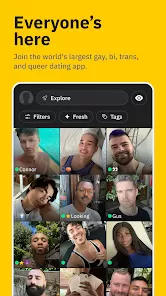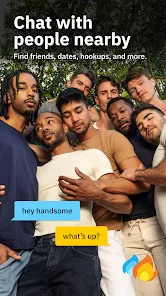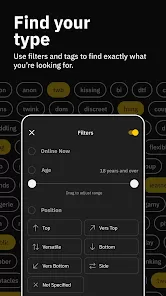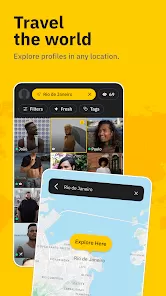Grindr is a location-based social networking and dating application primarily geared towards gay, bi, trans, and queer people. Launched in 2009, Grindr revolutionized the dating scene for the LGBTQ+ community by allowing users to connect with others in their vicinity. The app uses GPS technology to display profiles of nearby users, making it easy for people to meet and interact.
Features of Grindr
Profile Creation: Users can create profiles with photos, a bio, and details such as age, ethnicity, relationship status, and preferences.
Location-Based Matching: Grindr shows profiles based on the user's current location, updating in real-time as users move.
Messaging: Users can send text messages, photos, and audio messages. There is also a feature for sending one's location.
Explore Mode: This allows users to browse profiles from other locations around the world, not just nearby.
Tribes: Users can identify with one or more “tribes” (e.g., Bear, Twink, Daddy) to better define their profile and preferences.
Taps: A feature that lets users show interest in others by tapping their profile, similar to a 'like'.
Favorites: Users can mark other profiles as favorites for quick access.
Blocking: Users can block others to prevent any unwanted interactions.
Grindr XTRA: A premium subscription that offers additional features like no ads, more profile views, and more filtering options.
Video Chat: Enables users to have face-to-face conversations within the app.
Pros of Grindr
Wide User Base: As one of the most popular LGBTQ+ dating apps, it has millions of users worldwide, increasing the chances of finding a match.
Convenient and Real-Time: Location-based matching makes it easy to find people nearby for quick and spontaneous meetings.
User-Friendly Interface: The app is designed to be straightforward and easy to navigate.
Privacy Controls: Users can manage who sees their profile and can block users if needed.
Community and Inclusivity: Grindr fosters a sense of community among LGBTQ+ individuals and supports inclusivity with features like Tribes.
Cons of Grindr
Safety Concerns: The real-time location feature can pose risks if users are not careful about sharing their location.
Harassment and Discrimination: Some users report experiencing harassment or discriminatory behavior on the app.
Privacy Issues: There have been concerns about data privacy and security breaches in the past.
Superficial Interactions: The focus on quick, location-based connections can lead to more superficial interactions.
Addiction Potential: The app's design can be addictive, leading to excessive screen time and negative impacts on mental health.
How to Use Grindr
Download and Install: The app is available for free on iOS and Android platforms. Download it from the App Store or Google Play.
Create an Account: Sign up with an email address or link to a social media account. Fill out your profile with a photo and personal details.
Enable Location Services: Allow the app to access your location to show nearby profiles.
Browse Profiles: View profiles of nearby users, and use filters to narrow down your search.
Send Messages or Taps: Reach out to other users via messaging or tap their profile to show interest.
Use Premium Features: Consider subscribing to Grindr XTRA for additional features like ad-free browsing and more advanced filters.
Stay Safe: Be cautious about sharing personal information and meeting strangers. Use the app’s blocking and reporting features to handle any unwanted interactions.
Explore and Connect: Use the app to meet new people, make friends, or find potential dates or hookups.
Conclusion
Grindr offers a unique platform for LGBTQ+ individuals to connect and interact. With its real-time, location-based features, it provides a convenient way to meet new people nearby. However, users should be aware of privacy and safety concerns and use the app responsibly. Whether for dating, friendships, or community connections, Grindr continues to be a significant presence in the digital dating landscape.











 0
0 



